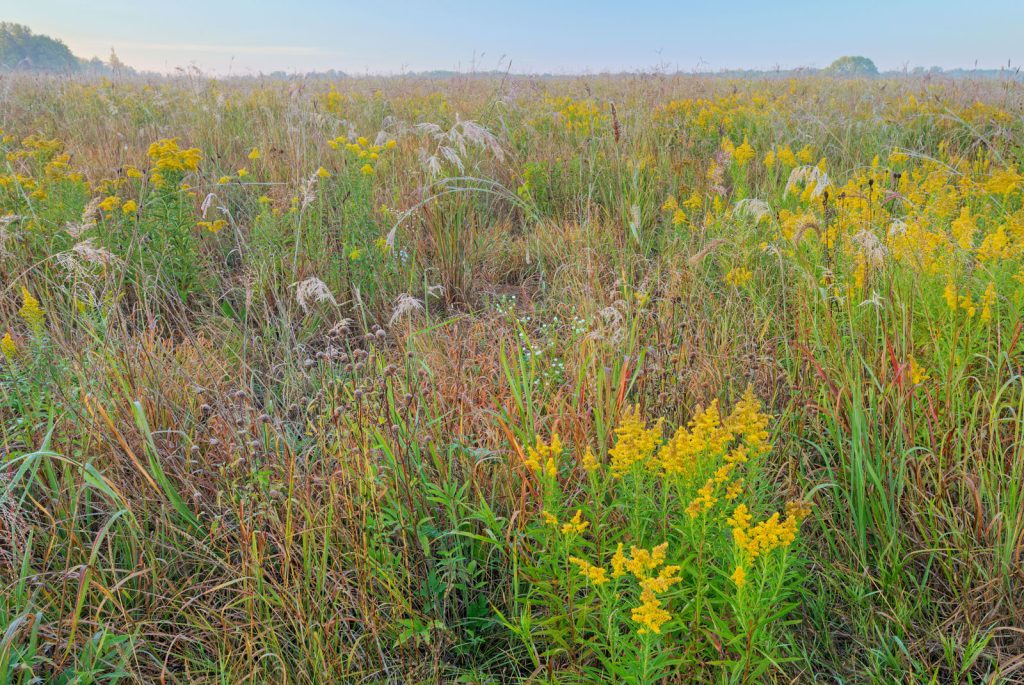
How restoring native prairies through CRP can improve biodiversity, reduce erosion, and support pollinators and wildlife.
Once spanning millions of acres across North America, native prairies have been dramatically reduced due to agriculture, development, and land fragmentation. Today, less than 1% of original tallgrass prairie remains, making restoration efforts more critical than ever.
Through the Conservation Reserve Program (CRP), landowners have a powerful opportunity to bring prairie ecosystems back to life, while also receiving financial support, improving their land, and contributing to long-term environmental health.
At All Native Seed, we specialize in providing the seed and guidance to help CRP participants successfully restore native prairies. Here’s a closer look at the many benefits of prairie restoration through CRP.
Boosting Biodiversity
Prairie ecosystems are among the most diverse in the world. Restoring native prairie habitat means reintroducing a wide variety of native grasses, wildflowers, pollinators, and wildlife.
- Diverse plant species create a stable, self-sustaining ecosystem.
- Pollinators like bees and butterflies benefit from continuous blooms throughout the season.
- Grassland birds, including many at-risk species, find essential nesting and foraging habitat.
CRP practices like CP2 (Native Grasses) and CP42 (Pollinator Habitat) support biodiversity by requiring diverse, regionally adapted seed mixes. This variety is key to rebuilding complex prairie systems and ensuring long-term resilience.
Reducing Soil Erosion and Improving Water Quality
One of the primary goals of CRP is to reduce soil erosion, and prairie restoration does that exceptionally well.
- Deep-rooted native grasses like Big Bluestem, Switchgrass, and Indiangrass anchor the soil, even on slopes and flood-prone areas.
- These roots improve water infiltration, reducing runoff and capturing sediment before it reaches waterways.
- Restored prairies act as natural filters, improving water quality by absorbing excess nutrients and preventing erosion-related pollution.
Compared to bare or heavily tilled land, restored prairies offer a dramatic improvement in both soil stability and water retention.
Supporting Pollinators and At-Risk Species
Restoring prairies through CRP directly supports the health of pollinators, many of which are in serious decline.
- CP42 Pollinator Habitat specifically requires diverse wildflower mixes to provide nectar and pollen across spring, summer, and fall.
- Native prairie plants support a wide range of specialist pollinators that rely on specific plant species.
- Species like the monarch butterfly, which depends on milkweed found in prairie habitats, benefit from restoration efforts.
By planting prairies with a mix of grasses and forbs, landowners can help reverse pollinator loss while improving their own land’s ecological value.
Creating Habitat for Wildlife
Prairie restoration through CRP provides habitat for a wide variety of wildlife species:
- Upland game birds, like quail and pheasants, use tall grasses for cover and nesting.
- Small mammals and reptiles thrive in dense, undisturbed prairie vegetation.
- Predatory birds such as hawks and owls benefit from increased prey availability in healthy ecosystems.
CRP practices like CP4D (Permanent Wildlife Habitat) and CP25 (Rare and Declining Habitat) are specifically designed to support wildlife by mimicking the structure and diversity of native prairie landscapes.
Increasing Land Value and Long-Term Sustainability
Beyond the environmental benefits, prairie restoration through CRP offers long-term value for landowners:
- Reduced erosion leads to healthier soils for future land use.
- Improved water quality and drainage benefit adjacent farmland and infrastructure.
- CRP rental payments and cost-share options provide a financial incentive while the land is protected and improved.
Restored prairies require less maintenance over time compared to invasive-dominated landscapes, resulting in lower management costs and greater ecological return.
All Native Seed: Your Prairie Restoration Partner
At All Native Seed, we provide everything you need to restore native prairie through CRP:
- NRCS-compliant native grass and wildflower seed mixes
- Expert support in selecting the right mix for your region, goals, and CRP practice
- Partnership with FDCE for establishment services when needed
With over 400,000 acres of habitat successfully established, we have the experience and tools to help your prairie planting thrive.
Ready to Restore Prairie on Your Land?
Prairie restoration through CRP is one of the most effective and rewarding ways to improve your land. Whether your goal is to reduce erosion, support pollinators, or simply leave a lasting environmental legacy, restoring prairie habitat is a smart and sustainable choice.
Contact All Native Seed today to learn more about our seed mixes and how we can support your CRP prairie restoration project from start to success.
